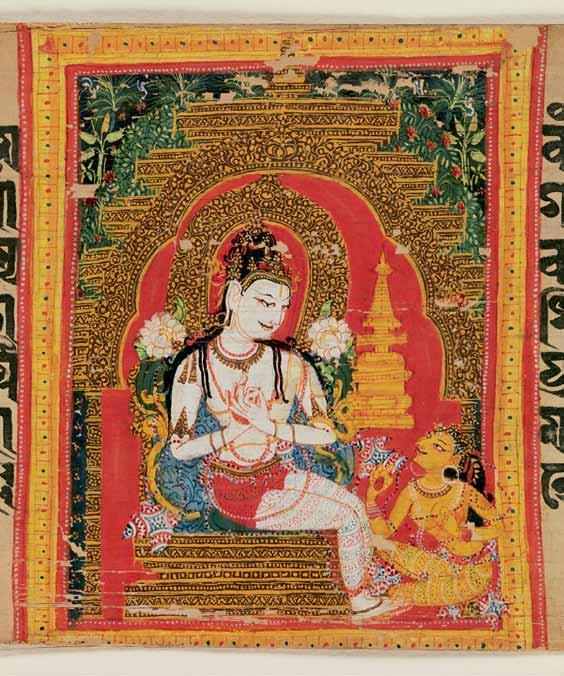
3 minute read
Mahavihara Master
Mahavihara Master Active in the early 12th century, in Bengal
This master painter of the Pala-era Buddhist monastic tradition is known from one extant palm-leaf manuscript, now shared between New York and Lhasa. The illustrated manuscript is a deluxe edition of the Ashtasahasrika Prajnaparamita (Perfection of Wisdom in 8,000 Verses), a Mahayanist text of profound importance to the development of esoteric Buddhist practice. The paintings that accompany this text display not only highly sophisticated painting skills but also such a sensitivity and empathy for the subject matter that one cannot avoid assuming the artist was a monk, deeply versed in the text he was engaged to illustrate. This pious artistic venture, to fulfill a royal commission, was probably undertaken in the scriptorium of one of the great monasteries (mahaviharas) of eastern India at the height of Buddhist activity there. The colophon leaf is preserved in Lhasa and although providing no clue about place or date of production, does identity the edition as “the pious gift of the queen Vihunadevi.” 18 As this queen is otherwise unknown, we have no means of constructing a provenance or reign date for her. Nevertheless, naming her as the donor fits a well-established pattern of female royal patrons of Buddhist religious art.
Advertisement
The Mahavihara Master displays a practiced ease combined with astute skill and sensitivity, resulting in miniature paintings of dazzling dexterity. His fluid lines and schematized color palette capture the sensuous flexing of the body profiles. The body colors are iconographically prescribed, as is the theatrical use of symbolic gestures (mudras). The subjects are standard, Buddhist saviors performing acts of charity and compassion: bodhisattvas and taras granting boons (No. 2) and expounding the dharma (No. 1), and Kurukulla protecting the faithful. The choices underscore the essentially talismanic function of these paintings, to extend protection to both the text they accompany and those who read it.
There is evidence, both in the text and beyond, that the Ashtasahasrika Prajnaparamita book became the focus of a cult of veneration and hence, worthy of extravagant embellishment. Certainly, these painted folios, among the oldest surviving masterworks of the Indian tradition, are appropriate to the task. The Mahavihara Master successfully miniaturized compositions originated for large-scale mural painting programs into a book format averaging 2½ by 3 inches (6.4 x 7.6 cm). That they convey the essence of the Buddhist dharma with grace, gravitas, and a sense of monumentality is all the more remarkable.
1 Bodhisattva Avalokitesvara expounding the dharma to a devotee: folio from an Ashtasahasrika Prajnaparamita manuscript Bengal, eastern India or Bangladesh, Pala period, early 12th century Opaque watercolor on palm-leaf, 2 3 ⁄4 x 16 1 ⁄2 in. (7 x 41.9 cm) The Metropolitan Museum of Art, New York, Purchase, Lila Acheson Wallace Gift, 2001 (2001.445.f)
The enthroned Avalokitesvara, bodhisattva of compassion, who is crowned, bejeweled, and framed by two white lotus blooms, sits in a temple shrine setting with bhadra-style superstructure of the Pala style. His hands held in double vitarkamudra preach the Perfection of Wisdom sutra to the female devotee who looks up in rapture at her savior. In this scene of powerful humanist sentiment, the psychological drama follows textual prescriptions describing how devotees should gaze on the deity. The Buddha essence (dhatu) is evoked by the depiction of a stupa, embodying the presence of both the Buddha relics and Buddha teachings.


2 Green Tara dispensing boons to ecstatic devotees: folio from an Ashtasahasrika Prajnaparamita manuscript Bengal, eastern India or Bangladesh, Pala period, early 12th century Opaque watercolor on palm-leaf, 2 3 ⁄4 x 16 1 ⁄2 in. (7 x 41.9 cm) The Metropolitan Museum of Art, New York, Purchase, Lila Acheson Wallace Gift, 2001 (2001.445.i) Published: Kossak, “Recent Acquisitions . . . Tara, the Buddhist Savioress” (2002), p. 60
This painting evokes the ecstatic character of worship in Indian religions. Here Mahayana Buddhism employs the visual language of bhakti, fervent and passionate devotion to god as devotees appeal to share in the Green Tara’s benevolence. Strings of pearls and gold-set jewels adorn her hair; diaphanous muslin drapes her fulsome breasts and reveals a short dhoti; and a golden throne-back arches with her body. She is accompanied by two divine attendees who share her golden pedestal and gaze up at her rapturously. The dense foliage that fills the background bursts out of the upper margin of the composition like some lush creeping vine, a foretaste of spatial devices used in later Hindu painting styles.










